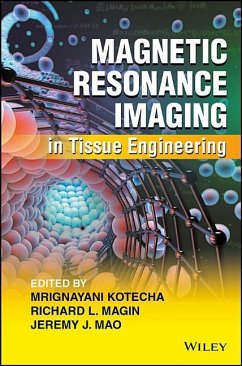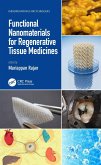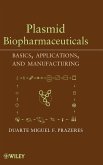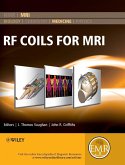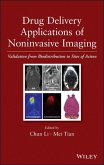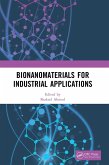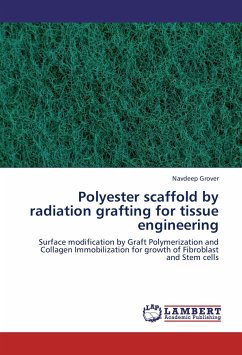Magnetic Resonance Imaging in Tissue Engineering
Herausgeber: Kotecha, Mrignayani; Mao, Jeremy J; Magin, Richard L
Magnetic Resonance Imaging in Tissue Engineering
Herausgeber: Kotecha, Mrignayani; Mao, Jeremy J; Magin, Richard L
- Gebundenes Buch
- Merkliste
- Auf die Merkliste
- Bewerten Bewerten
- Teilen
- Produkt teilen
- Produkterinnerung
- Produkterinnerung
Provides a unique overview of the field of noninvasive magnetic resonance assessment of tissue engineering and regenerative medicine Groundbreaking work in tissue-engineering and regenerative medicine is paving the way for repairing and/or replacing biological tissues and organs. Engineers, scientists, and physicians work together in this field to use biomaterials and cells as the building blocks for new life. One of the newest and most exciting areas of tissue engineering is the incorporation of bio-inspired cues into scaffolds through techniques such as patterning of topographies and…mehr
Andere Kunden interessierten sich auch für
![Functional Nanomaterials for Regenerative Tissue Medicines Functional Nanomaterials for Regenerative Tissue Medicines]() Functional Nanomaterials for Regenerative Tissue Medicines218,99 €
Functional Nanomaterials for Regenerative Tissue Medicines218,99 €![X-ray Radiation and Artificial Bragg Structures X-ray Radiation and Artificial Bragg Structures]() Jean-Michel AndreX-ray Radiation and Artificial Bragg Structures173,99 €
Jean-Michel AndreX-ray Radiation and Artificial Bragg Structures173,99 €![Plasmid Biopharmaceuticals Plasmid Biopharmaceuticals]() Duarte Miguel F. PrazeresPlasmid Biopharmaceuticals200,99 €
Duarte Miguel F. PrazeresPlasmid Biopharmaceuticals200,99 €![RF Coils for MRI RF Coils for MRI]() RF Coils for MRI229,99 €
RF Coils for MRI229,99 €![Drug Delivery Applications of Noninvasive Imaging Drug Delivery Applications of Noninvasive Imaging]() Mei TianDrug Delivery Applications of Noninvasive Imaging208,99 €
Mei TianDrug Delivery Applications of Noninvasive Imaging208,99 €![Bionanomaterials for Industrial Applications Bionanomaterials for Industrial Applications]() Bionanomaterials for Industrial Applications251,99 €
Bionanomaterials for Industrial Applications251,99 €![Polyester scaffold by radiation grafting for tissue engineering Polyester scaffold by radiation grafting for tissue engineering]() Navdeep GroverPolyester scaffold by radiation grafting for tissue engineering53,99 €
Navdeep GroverPolyester scaffold by radiation grafting for tissue engineering53,99 €
Provides a unique overview of the field of noninvasive magnetic resonance assessment of tissue engineering and regenerative medicine Groundbreaking work in tissue-engineering and regenerative medicine is paving the way for repairing and/or replacing biological tissues and organs. Engineers, scientists, and physicians work together in this field to use biomaterials and cells as the building blocks for new life. One of the newest and most exciting areas of tissue engineering is the incorporation of bio-inspired cues into scaffolds through techniques such as patterning of topographies and adhesive ligands. These cues can influence cellular functions, including differentiation, in new ways that are being discovered every day and are paving the way for cutting-edge clinical breakthroughs in areas such as cardiovascular tissue engineering, bone repair, and organ regeneration. Magnetic Resonance Imaging in Tissue Engineering is designed to provide in-depth analysis of advances made in the MRI assessment of tissue-engineering applications during the last decade. The book features: * Comprehensive details of magnetic resonance imaging (MRI) techniques used to assess a variety of engineered and regenerating tissues and organs * New techniques to assess engineered tissues * Cell-based therapies and engineered cartilage, bone, musculoskeletal, tendon, ligament, dental, craniofacial, cardiovascular, liver, bladder, and peripheral nerve tissue engineering and regeneration assessed by MRI Magnetic Resonance Imaging in Tissue Engineering contains chapters from leading experts working to develop robust functional engineered tissues and from analytical experts developing new magnetic resonance imaging techniques to assess engineered tissues. This rare interdisciplinary project is developed to bridge a gap in current offerings. Readers from both tissue-engineering and imaging backgrounds will find this interdisciplinary material useful in their research.
Hinweis: Dieser Artikel kann nur an eine deutsche Lieferadresse ausgeliefert werden.
Hinweis: Dieser Artikel kann nur an eine deutsche Lieferadresse ausgeliefert werden.
Produktdetails
- Produktdetails
- Verlag: Wiley
- Seitenzahl: 432
- Erscheinungstermin: 6. März 2017
- Englisch
- Abmessung: 231mm x 157mm x 20mm
- Gewicht: 499g
- ISBN-13: 9781119193357
- ISBN-10: 1119193354
- Artikelnr.: 44558709
- Herstellerkennzeichnung
- Libri GmbH
- Europaallee 1
- 36244 Bad Hersfeld
- gpsr@libri.de
- Verlag: Wiley
- Seitenzahl: 432
- Erscheinungstermin: 6. März 2017
- Englisch
- Abmessung: 231mm x 157mm x 20mm
- Gewicht: 499g
- ISBN-13: 9781119193357
- ISBN-10: 1119193354
- Artikelnr.: 44558709
- Herstellerkennzeichnung
- Libri GmbH
- Europaallee 1
- 36244 Bad Hersfeld
- gpsr@libri.de
MRIGNAYANI KOTECHA is currently a research professor of bioengineering at University of Illinois at Chicago and directs the Biomolecular Magnetic Resonance Spectroscopy and Imaging Laboratory (BMRSI). In this position, she is developing proton and sodium magnetic resonance spectroscopy (MRS) and magnetic resonance imaging (MRI) techniques for monitoring the growth of musculoskeletal engineered tissues. Her broad research interests include the application of MRI-based techniques to cell and tissue-based regenerative medicine. RICHARD L. MAGIN is currently a professor of bioengineering at University of Illinois at Chicago and directs the Diagnostic NMR Systems Laboratory, USA. Professor Magin is a fellow of the IEEE and AIMBE and a former editor of Critical Reviews in Biomedical Engineering. In 2012 he was designated a "Distinguished" Professor of Bioengineering at UIC. His research interests focus on the applications of magnetic resonance imaging (MRI) in science and engineering. JEREMY J. MAO is currently professor at Columbia University, USA, and also Edwin S. Robinson Endowed Chair. Dr. Mao's research team has been at Columbia for the past 7 years and made several important discoveries including a cover article in The Lancet. In addition, Dr. Mao's work has been published in Nature Medicine, The Lancet, Cell Stem Cell, JCI, and so on. Altogether Dr. Mao has published over 260 scientific papers and proceedings and written 2 books. Dr. Mao's research has led to over 70 patents and establishment of 2 biotechnology companies. Dr. Mao has received a number of prestigious awards including Yasuda Award and Spanadel Award.
List of Plates xiii About the Editors xix List of Contributors xxi Foreword xxv Preface xxvii Book Summary xxxi Part I Enabling Magnetic Resonance Techniques for Tissue Engineering Applications 1 1 Stem Cell Tissue Engineering and Regenerative Medicine: Role of Imaging 3 Bo Chen, Caleb Liebman, Parisa Rabbani, and Michael Cho 1.1 Introduction 3 1.2 3D Biomimetics 5 1.3 Assessment of Stem Cell Differentiation and Tissue Development 8 1.4 Description of Imaging Modalities for Tissue Engineering 8 1.4.1 Optical Microscopy 9 1.4.2 Fluorescence Microscopy 9 1.4.3 Multiphoton Microscopy 11 1.4.4 Magnetic Resonance Imaging 14 Acknowledgments 15 References 15 2 Principles and Applications of Quantitative Parametric MRI in Tissue Engineering 21 Mrignayani Kotecha 2.1 Introduction 21 2.2 Basics of MRI 25 2.2.1 Nuclear Spins 25 2.2.2 Radio Frequency Pulse Excitation and Relaxation 28 2.2.3 From MRS to MRI 31 2.3 MRI Contrasts for Tissue Engineering Applications 32 2.3.1 Chemical Shift 33 2.3.2 Relaxation Times-T1 and T2 33 2.3.3 Water Apparent Diffusion Coefficient 36 2.3.4 Fractional Anisotropy 37 2.4 X
Nuclei MRI for Tissue Engineering Applications 38 2.5 Preparing Engineered Tissues for MRI Assessment 38 2.5.1 In Vitro Assessment 38 2.5.2 In Vivo Assessment 39 2.6 Limitations of MRI Assessment in Tissue Engineering 39 2.7 Future Directions 40 2.7.1 Biomolecular Nuclear Magnetic Resonance 40 2.7.2 Cell-ECM-Biomaterial Interaction 40 2.7.3 Quantitative MRI 40 2.7.4 Standardization of MRI Methods for In Vitro and In Vivo Assessment 40 2.7.5 Super
Resolution MRI Techniques 41 2.7.6 Magnetic Resonance Elastography 41 2.7.7 Benchtop MRI 41 2.8 Conclusions 41 References 42 3 High Field Sodium MRS/MRI: Application to Cartilage Tissue Engineering 49 Mrignayani Kotecha 3.1 Introduction 49 3.2 Sodium as an MR Probe 50 3.3 Pulse Sequences 53 3.3.1 Pulse Sequences for Measuring TSC 53 3.3.2 TQC Pulse Sequences for Measuring
Q and
0
c 54 3.4 Assessment of Tissue
Engineered Cartilage 55 3.4.1 Proteoglycan Assessment 57 3.4.2 Assessment of Tissue Anisotropy and Molecular Dynamics 60 3.4.3 Assessment of Osteochondral Tissue Engineering 61 3.5 Sodium Biomarkers for Engineered Tissue Assessment 63 3.5.1 Engineered Tissue Sodium Concentration (ETSC) 63 3.5.2 Average Quadrupolar Coupling (
Q) 64 3.5.3 Motional Averaging Parameter (
0
c) 64 3.6 Future Directions 64 3.7 Summary 64 References 65 4 SPIO
Labeled Cellular MRI in Tissue Engineering: A Case Study in Growing Valvular Tissues 71 Elnaz Pour Issa and Sharan Ramaswamy 4.1 Setting the Stage: A Clinical Problem Requiring a Tissue Engineering Solution 71 4.2 SPIO Labeling of Cells 72 4.2.1 Ferumoxides 72 4.2.2 Transfection Agents 73 4.2.3 Labeling Protocols 75 4.3 Applications 76 4.3.1 Traditional Usage of SPIO
Labeled Cellular MRI 76 4.3.2 SPIO
Labeled Cellular MRI in Tissue Engineering 76 4.4 Case Study: SPIO
Labeled Cellular MRI for Heart Valve Tissue Engineering 77 4.4.1 Experimental Design 77 4.4.2 Potential Approaches-In Vitro 78 4.4.3 Potential Approaches-In Vivo 81 4.5 Conclusions and Future Outlook 83 Acknowledgment 84 References 84 5 Magnetic Resonance Elastography Applications in Tissue Engineering 91 Shadi F. Othman and Richard L. Magin 5.1 Introduction 91 5.2 Introduction to MRE 93 5.2.1 Theoretical Basis of MRE 94 5.2.2 The Inverse Problem and Direct Algebraic Inversion 96 5.2.3 Direct Algebraic Inversion Algorithm 101 5.3 Current Applications of MRE in Tissue Engineering and Regenerative Medicine 108 5.3.1 In Vitro TE
MRE 108 5.3.2 In Vivo TE
MRE 110 5.4 Conclusion 114 References 114 6 Finite
Element Method in MR Elastography: Application in Tissue Engineering 117 Yifei Liu and Thomas J. Royston 6.1 Introduction 117 6.2 FEA in MRE Inversion Algorithm Verification 118 6.3 FEM in Stiffness Estimation from MRE Data 120 6.4 FEA in Experimental Validation in Tissue Engineering Application 121 6.5 Conclusions and Discussion 124 Acknowledgment 125 References 125 7 In Vivo EPR Oxygen Imaging: A Case for Tissue Engineering 129 Boris Epel, Mrignayani Kotecha, and Howard J. Halpern 7.1 Introduction 129 7.2 History of EPROI 131 7.3 Principles of EPR Imaging 132 7.4 EPR Oxymetry 134 7.5 EPROI Instrumentation and Methodology 135 7.5.1 EPR Frequency 135 7.5.2 Resonators 135 7.5.3 Magnets 136 7.5.4 EPR Imagers 137 7.6 Spin Probes for Pulse EPR Oxymetry 138 7.7 Image Registration 139 7.8 Tissue Engineering Applications 140 7.8.1 EPROI in Scaffold Design 140 7.8.2 EPROI in Tissue Engineering 142 7.9 Summary and Future Outlook 142 Acknowledgment 142 References 143 Part II Tissue
Specific Applications of Magnetic Resonance Imaging in Tissue Engineering 149 8 Tissue
Engineered Grafts for Bone and Meniscus Regeneration and Their Assessment Using MRI 151 Hanying Bai, Mo Chen, Yongxing Liu, Qimei Gong, Ling He, Juan Zhong, Guodong Yang, Jinxuan Zheng, Xuguang Nie, Yixiong Zhang, and Jeremy J. Mao 8.1 Overview of Tissue Engineering with MRI 151 8.2 Assessment of Bone Regeneration by Tissue Engineering with MRI 152 8.3 MRI for 3D Modeling and 3D Print Manufacturing in Tissue Engineering 157 8.4 Assessment of Menisci Repair and Regeneration by Tissue Engineering with MRI 161 8.5 Conclusion 168 Acknowledgments 168 References 169 9 MRI Assessment of Engineered Cartilage Tissue Growth 179 Mrignayani Kotecha and Richard L. Magin 9.1 Introduction 179 9.2 Cartilage 181 9.3 Cartilage Tissue Engineering 182 9.3.1 Cells 183 9.3.1.1 Chondrocytes 183 9.3.1.2 Stem Cells 183 9.3.2 Biomaterials 183 9.3.3 Growth Factors 184 9.3.4 Growth Conditions 184 9.4 Animal Models in Cartilage Tissue Engineering 184 9.5 Tissue Growth Assessment 186 9.6 MRI in the Assessment of Tissue
Engineered Cartilage 187 9.7 Periodic Assessment of Tissue
Engineered Cartilage Using MRI 187 9.7.1 Assessment of Tissue Growth In Vitro 187 9.7.1.1 Accounting for Scaffold in Tissue Assessment 191 9.7.2 Assessment of Tissue Growth In Vivo 191 9.7.3 Assessment of Tissue Anisotropy and Dynamics 193 9.7.3.1 Assessment of Macromolecule Composition 194 9.7.3.2 Assessment of Tissue Anisotropy 198 9.8 Summary and Future Directions 199 References 200 10 Emerging Techniques for Tendon and Ligament MRI 209 Braden C. Fleming, Alison M. Biercevicz, Martha M. Murray, Weiguo Li, and Vincent M. Wang 10.1 Tendon and Ligament Structure, Function, Injury, and Healing 209 10.2 MRI Studies of Tendon and Ligament Healing 211 10.3 MRI and Contrast Mechanisms 219 10.3.1 Conventional MRI Techniques 219 10.3.2 Advanced MR Techniques 222 10.4 Significance and Conclusion 228 Acknowledgments 228 References 228 11 MRI of Engineered Dental and Craniofacial Tissues 237 Anne George and Sriram Ravindran 11.1 Introduction 237 11.2 Scaffolds 238 11.3 Extracellular Matrix 238 11.4 Tissue Regeneration of Dental-Craniofacial Complex 239 11.4.1 Advantages of Using ECM Scaffolds with Stem Cells 240 11.4.2 Stem Cells 242 11.5 MRI in Tissue Engineering and Regeneration 243 11.5.1 MRI of Human DPSCs 243 11.5.2 MRI of Tissue
Engineered Osteogenic Scaffolds 244 11.5.3 MRI of Chondrogenic Scaffolds with Cells In Vitro 244 11.5.4 MRI of Chondrogenic Scaffolds with Cells In Vivo 245 11.5.5 MRI Can Differentiate Between Engineered Bone and Engineered Cartilage 246 11.5.6 MRI to Assess Angiogenesis 246 11.6 Challenges and Future Directions for MRI in Tissue Engineering 246 Acknowledgments 247 References 247 12 Osteochondral Tissue Engineering: Noninvasive Assessment of Tissue Regeneration 251 Tyler Stahl, Abeid Anslip, Ling Lei, Nilse Dos Santos, Emmanuel Nwachuku, Thomas DeBerardino, and Syam Nukavarapu 12.1 Introduction 251 12.2 Osteochondral Tissue Engineering 252 12.2.1 Osteochondral Tissue 252 12.2.2 Biomaterials/Scaffolds 252 12.2.3 Cells 255 12.2.4 Growth Factors 256 12.3 Clinical Methods for Osteochondral Defect Repair and Assessment 257 12.3.1 Diagnostic Modalities 257 12.3.2 Treatment Methods 260 12.3.2.1 Microfracture 260 12.3.2.2 Autografts and Allografts 260 12.3.2.3 Tissue Engineering Grafts 262 12.4 MRI Assessment of Tissue Engineered Osteochondral Grafts 262 12.4.1 In Vitro Assessment 263 12.4.2 In Vivo Assessment 264 12.5 MRI Assessment Correlation with Histology 264 12.6 Conclusions and Challenges 265 Acknowledgments 265 References 265 13 Advanced Liver Tissue Engineering Approaches and Their Measure of Success Using NMR/MRI 273 Haakil Lee, Rex M. Jeffries, Andrey P. Tikunov, and Jeffrey M. Macdonald 13.1 Introduction 273 13.2 MRS and MRI Compatibilization-Building Compact RF MR Probes for BALs 278 13.3 Multinuclear MRS of a Hybrid Hollow Fiber-Microcarrier BAL 280 13.3.1 Viability by 31P MRS 282 13.3.2 Quantifying Drug Metabolic Activity and Oxygen Distribution by 19F MRS 284 13.4 1H MRI of a Hollow Fiber Multicoaxial BAL 286 13.4.1 BAL Integrity and Quality Assurance 286 13.4.2 Inoculation Efficiency and Prototype Redesign Iteration 288 13.4.3 Flow Dynamics 289 13.4.4 Diffusion
Weighted and Functional Annotation Screening Technology (FAST) Dynamic Contrast MRI 291 13.5 Magnetic Contrast Agents Used in MRI of Liver Stem Cell Therapy 293 13.6 31P and 13C MRS of a Fluidized
Bed BAL Containing Encapsulated Hepatocytes 294 13.6.1 31P MRS Resolution, SNR, Viability, and pH 296 13.6.2 13C MRS to Monitor Real
Time Metabolism 296 13.7 Future Studies 298 13.7.1 Dynamic Nuclear Polarization 298 13.7.2 Constructing Artificial Organs 300 13.8 Discussion 301 Acknowledgment 303 References 303 14 MRI of Vascularized Tissue
Engineered Organs 311 Hai
Ling Margaret Cheng 14.1 Introduction 311 14.2 Importance of Vascularization in Tissue Engineering 312 14.3 Vessel Formation and Maturation: Implications for Imaging 314 14.4 Imaging Approaches to Assess Vascularization 317 14.5 Dynamic Contrast
Enhanced MRI for Imaging Vascular Physiology 318 14.6 Complementary MRI Techniques to Study Vascularization 321 14.7 Considerations for Preclinical Models and Translation to Clinical Implementation 325 14.8 Future Directions 326 14.9 Conclusions 327 References 327 15 MRI Tools for Assessment of Cardiovascular Tissue Engineering 333 Laurence H. Jackson, Mark F. Lythgoe, and Daniel J. Stuckey 15.1 The Heart and Heart Failure 333 15.2 Cardiac Engineering and Cell Therapy 334 15.3 Imaging Heart Failure 336 15.3.1 Cine MRI 336 15.3.2 Regional Heart Function 338 15.3.3 Viability Imaging 340 15.3.4 Relaxometry and Parametric Imaging 342 15.3.5 Myocardial Perfusion Imaging 344 15.4 Imaging Cardiac Regeneration 346 15.5 Monitoring Cardiac Regeneration 348 15.5.1 MRI to Track Stem Cells 348 15.5.2 MRI to Track Engineered Tissues 353 15.6 Translational Potential and Future Directions 355 References 357 16 Peripheral Nerve Tissue Engineering and Regeneration Observed Using MRI 367 Shan
Ho Chan and Shan
hui Hsu 16.1 Introduction 367 16.2 Receiver Coils Commonly Applied in Nerve Tissue Engineering 368 16.3 Various Tools for Real
Time Monitoring of the Nerve Regeneration 368 16.4 Current Materials, Methods, and Concepts in Peripheral Nerve Repair 368 16.5 MRI Parameters in Peripheral Nerve Tissue Engineering 371 16.6 Advantages of Real
Time Monitoring of Nerve Regeneration Using MRI 373 16.7 Choosing Animal Models for MRI Studies of Peripheral Nerve Tissue Engineering 374 16.8 Imaging Ability Through Nerve Conduits of Peripheral Nerve Tissue Engineering 375 16.9 Further Imaging Functions of MRI in Peripheral Nerve Tissue Engineering 376 16.10 Tractography in Peripheral Nerve Tissue Engineering 376 16.11 Novel Contrast Agents 378 16.12 Conclusions 378 References 379 Index 383
Nuclei MRI for Tissue Engineering Applications 38 2.5 Preparing Engineered Tissues for MRI Assessment 38 2.5.1 In Vitro Assessment 38 2.5.2 In Vivo Assessment 39 2.6 Limitations of MRI Assessment in Tissue Engineering 39 2.7 Future Directions 40 2.7.1 Biomolecular Nuclear Magnetic Resonance 40 2.7.2 Cell-ECM-Biomaterial Interaction 40 2.7.3 Quantitative MRI 40 2.7.4 Standardization of MRI Methods for In Vitro and In Vivo Assessment 40 2.7.5 Super
Resolution MRI Techniques 41 2.7.6 Magnetic Resonance Elastography 41 2.7.7 Benchtop MRI 41 2.8 Conclusions 41 References 42 3 High Field Sodium MRS/MRI: Application to Cartilage Tissue Engineering 49 Mrignayani Kotecha 3.1 Introduction 49 3.2 Sodium as an MR Probe 50 3.3 Pulse Sequences 53 3.3.1 Pulse Sequences for Measuring TSC 53 3.3.2 TQC Pulse Sequences for Measuring
Q and
0
c 54 3.4 Assessment of Tissue
Engineered Cartilage 55 3.4.1 Proteoglycan Assessment 57 3.4.2 Assessment of Tissue Anisotropy and Molecular Dynamics 60 3.4.3 Assessment of Osteochondral Tissue Engineering 61 3.5 Sodium Biomarkers for Engineered Tissue Assessment 63 3.5.1 Engineered Tissue Sodium Concentration (ETSC) 63 3.5.2 Average Quadrupolar Coupling (
Q) 64 3.5.3 Motional Averaging Parameter (
0
c) 64 3.6 Future Directions 64 3.7 Summary 64 References 65 4 SPIO
Labeled Cellular MRI in Tissue Engineering: A Case Study in Growing Valvular Tissues 71 Elnaz Pour Issa and Sharan Ramaswamy 4.1 Setting the Stage: A Clinical Problem Requiring a Tissue Engineering Solution 71 4.2 SPIO Labeling of Cells 72 4.2.1 Ferumoxides 72 4.2.2 Transfection Agents 73 4.2.3 Labeling Protocols 75 4.3 Applications 76 4.3.1 Traditional Usage of SPIO
Labeled Cellular MRI 76 4.3.2 SPIO
Labeled Cellular MRI in Tissue Engineering 76 4.4 Case Study: SPIO
Labeled Cellular MRI for Heart Valve Tissue Engineering 77 4.4.1 Experimental Design 77 4.4.2 Potential Approaches-In Vitro 78 4.4.3 Potential Approaches-In Vivo 81 4.5 Conclusions and Future Outlook 83 Acknowledgment 84 References 84 5 Magnetic Resonance Elastography Applications in Tissue Engineering 91 Shadi F. Othman and Richard L. Magin 5.1 Introduction 91 5.2 Introduction to MRE 93 5.2.1 Theoretical Basis of MRE 94 5.2.2 The Inverse Problem and Direct Algebraic Inversion 96 5.2.3 Direct Algebraic Inversion Algorithm 101 5.3 Current Applications of MRE in Tissue Engineering and Regenerative Medicine 108 5.3.1 In Vitro TE
MRE 108 5.3.2 In Vivo TE
MRE 110 5.4 Conclusion 114 References 114 6 Finite
Element Method in MR Elastography: Application in Tissue Engineering 117 Yifei Liu and Thomas J. Royston 6.1 Introduction 117 6.2 FEA in MRE Inversion Algorithm Verification 118 6.3 FEM in Stiffness Estimation from MRE Data 120 6.4 FEA in Experimental Validation in Tissue Engineering Application 121 6.5 Conclusions and Discussion 124 Acknowledgment 125 References 125 7 In Vivo EPR Oxygen Imaging: A Case for Tissue Engineering 129 Boris Epel, Mrignayani Kotecha, and Howard J. Halpern 7.1 Introduction 129 7.2 History of EPROI 131 7.3 Principles of EPR Imaging 132 7.4 EPR Oxymetry 134 7.5 EPROI Instrumentation and Methodology 135 7.5.1 EPR Frequency 135 7.5.2 Resonators 135 7.5.3 Magnets 136 7.5.4 EPR Imagers 137 7.6 Spin Probes for Pulse EPR Oxymetry 138 7.7 Image Registration 139 7.8 Tissue Engineering Applications 140 7.8.1 EPROI in Scaffold Design 140 7.8.2 EPROI in Tissue Engineering 142 7.9 Summary and Future Outlook 142 Acknowledgment 142 References 143 Part II Tissue
Specific Applications of Magnetic Resonance Imaging in Tissue Engineering 149 8 Tissue
Engineered Grafts for Bone and Meniscus Regeneration and Their Assessment Using MRI 151 Hanying Bai, Mo Chen, Yongxing Liu, Qimei Gong, Ling He, Juan Zhong, Guodong Yang, Jinxuan Zheng, Xuguang Nie, Yixiong Zhang, and Jeremy J. Mao 8.1 Overview of Tissue Engineering with MRI 151 8.2 Assessment of Bone Regeneration by Tissue Engineering with MRI 152 8.3 MRI for 3D Modeling and 3D Print Manufacturing in Tissue Engineering 157 8.4 Assessment of Menisci Repair and Regeneration by Tissue Engineering with MRI 161 8.5 Conclusion 168 Acknowledgments 168 References 169 9 MRI Assessment of Engineered Cartilage Tissue Growth 179 Mrignayani Kotecha and Richard L. Magin 9.1 Introduction 179 9.2 Cartilage 181 9.3 Cartilage Tissue Engineering 182 9.3.1 Cells 183 9.3.1.1 Chondrocytes 183 9.3.1.2 Stem Cells 183 9.3.2 Biomaterials 183 9.3.3 Growth Factors 184 9.3.4 Growth Conditions 184 9.4 Animal Models in Cartilage Tissue Engineering 184 9.5 Tissue Growth Assessment 186 9.6 MRI in the Assessment of Tissue
Engineered Cartilage 187 9.7 Periodic Assessment of Tissue
Engineered Cartilage Using MRI 187 9.7.1 Assessment of Tissue Growth In Vitro 187 9.7.1.1 Accounting for Scaffold in Tissue Assessment 191 9.7.2 Assessment of Tissue Growth In Vivo 191 9.7.3 Assessment of Tissue Anisotropy and Dynamics 193 9.7.3.1 Assessment of Macromolecule Composition 194 9.7.3.2 Assessment of Tissue Anisotropy 198 9.8 Summary and Future Directions 199 References 200 10 Emerging Techniques for Tendon and Ligament MRI 209 Braden C. Fleming, Alison M. Biercevicz, Martha M. Murray, Weiguo Li, and Vincent M. Wang 10.1 Tendon and Ligament Structure, Function, Injury, and Healing 209 10.2 MRI Studies of Tendon and Ligament Healing 211 10.3 MRI and Contrast Mechanisms 219 10.3.1 Conventional MRI Techniques 219 10.3.2 Advanced MR Techniques 222 10.4 Significance and Conclusion 228 Acknowledgments 228 References 228 11 MRI of Engineered Dental and Craniofacial Tissues 237 Anne George and Sriram Ravindran 11.1 Introduction 237 11.2 Scaffolds 238 11.3 Extracellular Matrix 238 11.4 Tissue Regeneration of Dental-Craniofacial Complex 239 11.4.1 Advantages of Using ECM Scaffolds with Stem Cells 240 11.4.2 Stem Cells 242 11.5 MRI in Tissue Engineering and Regeneration 243 11.5.1 MRI of Human DPSCs 243 11.5.2 MRI of Tissue
Engineered Osteogenic Scaffolds 244 11.5.3 MRI of Chondrogenic Scaffolds with Cells In Vitro 244 11.5.4 MRI of Chondrogenic Scaffolds with Cells In Vivo 245 11.5.5 MRI Can Differentiate Between Engineered Bone and Engineered Cartilage 246 11.5.6 MRI to Assess Angiogenesis 246 11.6 Challenges and Future Directions for MRI in Tissue Engineering 246 Acknowledgments 247 References 247 12 Osteochondral Tissue Engineering: Noninvasive Assessment of Tissue Regeneration 251 Tyler Stahl, Abeid Anslip, Ling Lei, Nilse Dos Santos, Emmanuel Nwachuku, Thomas DeBerardino, and Syam Nukavarapu 12.1 Introduction 251 12.2 Osteochondral Tissue Engineering 252 12.2.1 Osteochondral Tissue 252 12.2.2 Biomaterials/Scaffolds 252 12.2.3 Cells 255 12.2.4 Growth Factors 256 12.3 Clinical Methods for Osteochondral Defect Repair and Assessment 257 12.3.1 Diagnostic Modalities 257 12.3.2 Treatment Methods 260 12.3.2.1 Microfracture 260 12.3.2.2 Autografts and Allografts 260 12.3.2.3 Tissue Engineering Grafts 262 12.4 MRI Assessment of Tissue Engineered Osteochondral Grafts 262 12.4.1 In Vitro Assessment 263 12.4.2 In Vivo Assessment 264 12.5 MRI Assessment Correlation with Histology 264 12.6 Conclusions and Challenges 265 Acknowledgments 265 References 265 13 Advanced Liver Tissue Engineering Approaches and Their Measure of Success Using NMR/MRI 273 Haakil Lee, Rex M. Jeffries, Andrey P. Tikunov, and Jeffrey M. Macdonald 13.1 Introduction 273 13.2 MRS and MRI Compatibilization-Building Compact RF MR Probes for BALs 278 13.3 Multinuclear MRS of a Hybrid Hollow Fiber-Microcarrier BAL 280 13.3.1 Viability by 31P MRS 282 13.3.2 Quantifying Drug Metabolic Activity and Oxygen Distribution by 19F MRS 284 13.4 1H MRI of a Hollow Fiber Multicoaxial BAL 286 13.4.1 BAL Integrity and Quality Assurance 286 13.4.2 Inoculation Efficiency and Prototype Redesign Iteration 288 13.4.3 Flow Dynamics 289 13.4.4 Diffusion
Weighted and Functional Annotation Screening Technology (FAST) Dynamic Contrast MRI 291 13.5 Magnetic Contrast Agents Used in MRI of Liver Stem Cell Therapy 293 13.6 31P and 13C MRS of a Fluidized
Bed BAL Containing Encapsulated Hepatocytes 294 13.6.1 31P MRS Resolution, SNR, Viability, and pH 296 13.6.2 13C MRS to Monitor Real
Time Metabolism 296 13.7 Future Studies 298 13.7.1 Dynamic Nuclear Polarization 298 13.7.2 Constructing Artificial Organs 300 13.8 Discussion 301 Acknowledgment 303 References 303 14 MRI of Vascularized Tissue
Engineered Organs 311 Hai
Ling Margaret Cheng 14.1 Introduction 311 14.2 Importance of Vascularization in Tissue Engineering 312 14.3 Vessel Formation and Maturation: Implications for Imaging 314 14.4 Imaging Approaches to Assess Vascularization 317 14.5 Dynamic Contrast
Enhanced MRI for Imaging Vascular Physiology 318 14.6 Complementary MRI Techniques to Study Vascularization 321 14.7 Considerations for Preclinical Models and Translation to Clinical Implementation 325 14.8 Future Directions 326 14.9 Conclusions 327 References 327 15 MRI Tools for Assessment of Cardiovascular Tissue Engineering 333 Laurence H. Jackson, Mark F. Lythgoe, and Daniel J. Stuckey 15.1 The Heart and Heart Failure 333 15.2 Cardiac Engineering and Cell Therapy 334 15.3 Imaging Heart Failure 336 15.3.1 Cine MRI 336 15.3.2 Regional Heart Function 338 15.3.3 Viability Imaging 340 15.3.4 Relaxometry and Parametric Imaging 342 15.3.5 Myocardial Perfusion Imaging 344 15.4 Imaging Cardiac Regeneration 346 15.5 Monitoring Cardiac Regeneration 348 15.5.1 MRI to Track Stem Cells 348 15.5.2 MRI to Track Engineered Tissues 353 15.6 Translational Potential and Future Directions 355 References 357 16 Peripheral Nerve Tissue Engineering and Regeneration Observed Using MRI 367 Shan
Ho Chan and Shan
hui Hsu 16.1 Introduction 367 16.2 Receiver Coils Commonly Applied in Nerve Tissue Engineering 368 16.3 Various Tools for Real
Time Monitoring of the Nerve Regeneration 368 16.4 Current Materials, Methods, and Concepts in Peripheral Nerve Repair 368 16.5 MRI Parameters in Peripheral Nerve Tissue Engineering 371 16.6 Advantages of Real
Time Monitoring of Nerve Regeneration Using MRI 373 16.7 Choosing Animal Models for MRI Studies of Peripheral Nerve Tissue Engineering 374 16.8 Imaging Ability Through Nerve Conduits of Peripheral Nerve Tissue Engineering 375 16.9 Further Imaging Functions of MRI in Peripheral Nerve Tissue Engineering 376 16.10 Tractography in Peripheral Nerve Tissue Engineering 376 16.11 Novel Contrast Agents 378 16.12 Conclusions 378 References 379 Index 383
List of Plates xiii About the Editors xix List of Contributors xxi Foreword xxv Preface xxvii Book Summary xxxi Part I Enabling Magnetic Resonance Techniques for Tissue Engineering Applications 1 1 Stem Cell Tissue Engineering and Regenerative Medicine: Role of Imaging 3 Bo Chen, Caleb Liebman, Parisa Rabbani, and Michael Cho 1.1 Introduction 3 1.2 3D Biomimetics 5 1.3 Assessment of Stem Cell Differentiation and Tissue Development 8 1.4 Description of Imaging Modalities for Tissue Engineering 8 1.4.1 Optical Microscopy 9 1.4.2 Fluorescence Microscopy 9 1.4.3 Multiphoton Microscopy 11 1.4.4 Magnetic Resonance Imaging 14 Acknowledgments 15 References 15 2 Principles and Applications of Quantitative Parametric MRI in Tissue Engineering 21 Mrignayani Kotecha 2.1 Introduction 21 2.2 Basics of MRI 25 2.2.1 Nuclear Spins 25 2.2.2 Radio Frequency Pulse Excitation and Relaxation 28 2.2.3 From MRS to MRI 31 2.3 MRI Contrasts for Tissue Engineering Applications 32 2.3.1 Chemical Shift 33 2.3.2 Relaxation Times-T1 and T2 33 2.3.3 Water Apparent Diffusion Coefficient 36 2.3.4 Fractional Anisotropy 37 2.4 X
Nuclei MRI for Tissue Engineering Applications 38 2.5 Preparing Engineered Tissues for MRI Assessment 38 2.5.1 In Vitro Assessment 38 2.5.2 In Vivo Assessment 39 2.6 Limitations of MRI Assessment in Tissue Engineering 39 2.7 Future Directions 40 2.7.1 Biomolecular Nuclear Magnetic Resonance 40 2.7.2 Cell-ECM-Biomaterial Interaction 40 2.7.3 Quantitative MRI 40 2.7.4 Standardization of MRI Methods for In Vitro and In Vivo Assessment 40 2.7.5 Super
Resolution MRI Techniques 41 2.7.6 Magnetic Resonance Elastography 41 2.7.7 Benchtop MRI 41 2.8 Conclusions 41 References 42 3 High Field Sodium MRS/MRI: Application to Cartilage Tissue Engineering 49 Mrignayani Kotecha 3.1 Introduction 49 3.2 Sodium as an MR Probe 50 3.3 Pulse Sequences 53 3.3.1 Pulse Sequences for Measuring TSC 53 3.3.2 TQC Pulse Sequences for Measuring
Q and
0
c 54 3.4 Assessment of Tissue
Engineered Cartilage 55 3.4.1 Proteoglycan Assessment 57 3.4.2 Assessment of Tissue Anisotropy and Molecular Dynamics 60 3.4.3 Assessment of Osteochondral Tissue Engineering 61 3.5 Sodium Biomarkers for Engineered Tissue Assessment 63 3.5.1 Engineered Tissue Sodium Concentration (ETSC) 63 3.5.2 Average Quadrupolar Coupling (
Q) 64 3.5.3 Motional Averaging Parameter (
0
c) 64 3.6 Future Directions 64 3.7 Summary 64 References 65 4 SPIO
Labeled Cellular MRI in Tissue Engineering: A Case Study in Growing Valvular Tissues 71 Elnaz Pour Issa and Sharan Ramaswamy 4.1 Setting the Stage: A Clinical Problem Requiring a Tissue Engineering Solution 71 4.2 SPIO Labeling of Cells 72 4.2.1 Ferumoxides 72 4.2.2 Transfection Agents 73 4.2.3 Labeling Protocols 75 4.3 Applications 76 4.3.1 Traditional Usage of SPIO
Labeled Cellular MRI 76 4.3.2 SPIO
Labeled Cellular MRI in Tissue Engineering 76 4.4 Case Study: SPIO
Labeled Cellular MRI for Heart Valve Tissue Engineering 77 4.4.1 Experimental Design 77 4.4.2 Potential Approaches-In Vitro 78 4.4.3 Potential Approaches-In Vivo 81 4.5 Conclusions and Future Outlook 83 Acknowledgment 84 References 84 5 Magnetic Resonance Elastography Applications in Tissue Engineering 91 Shadi F. Othman and Richard L. Magin 5.1 Introduction 91 5.2 Introduction to MRE 93 5.2.1 Theoretical Basis of MRE 94 5.2.2 The Inverse Problem and Direct Algebraic Inversion 96 5.2.3 Direct Algebraic Inversion Algorithm 101 5.3 Current Applications of MRE in Tissue Engineering and Regenerative Medicine 108 5.3.1 In Vitro TE
MRE 108 5.3.2 In Vivo TE
MRE 110 5.4 Conclusion 114 References 114 6 Finite
Element Method in MR Elastography: Application in Tissue Engineering 117 Yifei Liu and Thomas J. Royston 6.1 Introduction 117 6.2 FEA in MRE Inversion Algorithm Verification 118 6.3 FEM in Stiffness Estimation from MRE Data 120 6.4 FEA in Experimental Validation in Tissue Engineering Application 121 6.5 Conclusions and Discussion 124 Acknowledgment 125 References 125 7 In Vivo EPR Oxygen Imaging: A Case for Tissue Engineering 129 Boris Epel, Mrignayani Kotecha, and Howard J. Halpern 7.1 Introduction 129 7.2 History of EPROI 131 7.3 Principles of EPR Imaging 132 7.4 EPR Oxymetry 134 7.5 EPROI Instrumentation and Methodology 135 7.5.1 EPR Frequency 135 7.5.2 Resonators 135 7.5.3 Magnets 136 7.5.4 EPR Imagers 137 7.6 Spin Probes for Pulse EPR Oxymetry 138 7.7 Image Registration 139 7.8 Tissue Engineering Applications 140 7.8.1 EPROI in Scaffold Design 140 7.8.2 EPROI in Tissue Engineering 142 7.9 Summary and Future Outlook 142 Acknowledgment 142 References 143 Part II Tissue
Specific Applications of Magnetic Resonance Imaging in Tissue Engineering 149 8 Tissue
Engineered Grafts for Bone and Meniscus Regeneration and Their Assessment Using MRI 151 Hanying Bai, Mo Chen, Yongxing Liu, Qimei Gong, Ling He, Juan Zhong, Guodong Yang, Jinxuan Zheng, Xuguang Nie, Yixiong Zhang, and Jeremy J. Mao 8.1 Overview of Tissue Engineering with MRI 151 8.2 Assessment of Bone Regeneration by Tissue Engineering with MRI 152 8.3 MRI for 3D Modeling and 3D Print Manufacturing in Tissue Engineering 157 8.4 Assessment of Menisci Repair and Regeneration by Tissue Engineering with MRI 161 8.5 Conclusion 168 Acknowledgments 168 References 169 9 MRI Assessment of Engineered Cartilage Tissue Growth 179 Mrignayani Kotecha and Richard L. Magin 9.1 Introduction 179 9.2 Cartilage 181 9.3 Cartilage Tissue Engineering 182 9.3.1 Cells 183 9.3.1.1 Chondrocytes 183 9.3.1.2 Stem Cells 183 9.3.2 Biomaterials 183 9.3.3 Growth Factors 184 9.3.4 Growth Conditions 184 9.4 Animal Models in Cartilage Tissue Engineering 184 9.5 Tissue Growth Assessment 186 9.6 MRI in the Assessment of Tissue
Engineered Cartilage 187 9.7 Periodic Assessment of Tissue
Engineered Cartilage Using MRI 187 9.7.1 Assessment of Tissue Growth In Vitro 187 9.7.1.1 Accounting for Scaffold in Tissue Assessment 191 9.7.2 Assessment of Tissue Growth In Vivo 191 9.7.3 Assessment of Tissue Anisotropy and Dynamics 193 9.7.3.1 Assessment of Macromolecule Composition 194 9.7.3.2 Assessment of Tissue Anisotropy 198 9.8 Summary and Future Directions 199 References 200 10 Emerging Techniques for Tendon and Ligament MRI 209 Braden C. Fleming, Alison M. Biercevicz, Martha M. Murray, Weiguo Li, and Vincent M. Wang 10.1 Tendon and Ligament Structure, Function, Injury, and Healing 209 10.2 MRI Studies of Tendon and Ligament Healing 211 10.3 MRI and Contrast Mechanisms 219 10.3.1 Conventional MRI Techniques 219 10.3.2 Advanced MR Techniques 222 10.4 Significance and Conclusion 228 Acknowledgments 228 References 228 11 MRI of Engineered Dental and Craniofacial Tissues 237 Anne George and Sriram Ravindran 11.1 Introduction 237 11.2 Scaffolds 238 11.3 Extracellular Matrix 238 11.4 Tissue Regeneration of Dental-Craniofacial Complex 239 11.4.1 Advantages of Using ECM Scaffolds with Stem Cells 240 11.4.2 Stem Cells 242 11.5 MRI in Tissue Engineering and Regeneration 243 11.5.1 MRI of Human DPSCs 243 11.5.2 MRI of Tissue
Engineered Osteogenic Scaffolds 244 11.5.3 MRI of Chondrogenic Scaffolds with Cells In Vitro 244 11.5.4 MRI of Chondrogenic Scaffolds with Cells In Vivo 245 11.5.5 MRI Can Differentiate Between Engineered Bone and Engineered Cartilage 246 11.5.6 MRI to Assess Angiogenesis 246 11.6 Challenges and Future Directions for MRI in Tissue Engineering 246 Acknowledgments 247 References 247 12 Osteochondral Tissue Engineering: Noninvasive Assessment of Tissue Regeneration 251 Tyler Stahl, Abeid Anslip, Ling Lei, Nilse Dos Santos, Emmanuel Nwachuku, Thomas DeBerardino, and Syam Nukavarapu 12.1 Introduction 251 12.2 Osteochondral Tissue Engineering 252 12.2.1 Osteochondral Tissue 252 12.2.2 Biomaterials/Scaffolds 252 12.2.3 Cells 255 12.2.4 Growth Factors 256 12.3 Clinical Methods for Osteochondral Defect Repair and Assessment 257 12.3.1 Diagnostic Modalities 257 12.3.2 Treatment Methods 260 12.3.2.1 Microfracture 260 12.3.2.2 Autografts and Allografts 260 12.3.2.3 Tissue Engineering Grafts 262 12.4 MRI Assessment of Tissue Engineered Osteochondral Grafts 262 12.4.1 In Vitro Assessment 263 12.4.2 In Vivo Assessment 264 12.5 MRI Assessment Correlation with Histology 264 12.6 Conclusions and Challenges 265 Acknowledgments 265 References 265 13 Advanced Liver Tissue Engineering Approaches and Their Measure of Success Using NMR/MRI 273 Haakil Lee, Rex M. Jeffries, Andrey P. Tikunov, and Jeffrey M. Macdonald 13.1 Introduction 273 13.2 MRS and MRI Compatibilization-Building Compact RF MR Probes for BALs 278 13.3 Multinuclear MRS of a Hybrid Hollow Fiber-Microcarrier BAL 280 13.3.1 Viability by 31P MRS 282 13.3.2 Quantifying Drug Metabolic Activity and Oxygen Distribution by 19F MRS 284 13.4 1H MRI of a Hollow Fiber Multicoaxial BAL 286 13.4.1 BAL Integrity and Quality Assurance 286 13.4.2 Inoculation Efficiency and Prototype Redesign Iteration 288 13.4.3 Flow Dynamics 289 13.4.4 Diffusion
Weighted and Functional Annotation Screening Technology (FAST) Dynamic Contrast MRI 291 13.5 Magnetic Contrast Agents Used in MRI of Liver Stem Cell Therapy 293 13.6 31P and 13C MRS of a Fluidized
Bed BAL Containing Encapsulated Hepatocytes 294 13.6.1 31P MRS Resolution, SNR, Viability, and pH 296 13.6.2 13C MRS to Monitor Real
Time Metabolism 296 13.7 Future Studies 298 13.7.1 Dynamic Nuclear Polarization 298 13.7.2 Constructing Artificial Organs 300 13.8 Discussion 301 Acknowledgment 303 References 303 14 MRI of Vascularized Tissue
Engineered Organs 311 Hai
Ling Margaret Cheng 14.1 Introduction 311 14.2 Importance of Vascularization in Tissue Engineering 312 14.3 Vessel Formation and Maturation: Implications for Imaging 314 14.4 Imaging Approaches to Assess Vascularization 317 14.5 Dynamic Contrast
Enhanced MRI for Imaging Vascular Physiology 318 14.6 Complementary MRI Techniques to Study Vascularization 321 14.7 Considerations for Preclinical Models and Translation to Clinical Implementation 325 14.8 Future Directions 326 14.9 Conclusions 327 References 327 15 MRI Tools for Assessment of Cardiovascular Tissue Engineering 333 Laurence H. Jackson, Mark F. Lythgoe, and Daniel J. Stuckey 15.1 The Heart and Heart Failure 333 15.2 Cardiac Engineering and Cell Therapy 334 15.3 Imaging Heart Failure 336 15.3.1 Cine MRI 336 15.3.2 Regional Heart Function 338 15.3.3 Viability Imaging 340 15.3.4 Relaxometry and Parametric Imaging 342 15.3.5 Myocardial Perfusion Imaging 344 15.4 Imaging Cardiac Regeneration 346 15.5 Monitoring Cardiac Regeneration 348 15.5.1 MRI to Track Stem Cells 348 15.5.2 MRI to Track Engineered Tissues 353 15.6 Translational Potential and Future Directions 355 References 357 16 Peripheral Nerve Tissue Engineering and Regeneration Observed Using MRI 367 Shan
Ho Chan and Shan
hui Hsu 16.1 Introduction 367 16.2 Receiver Coils Commonly Applied in Nerve Tissue Engineering 368 16.3 Various Tools for Real
Time Monitoring of the Nerve Regeneration 368 16.4 Current Materials, Methods, and Concepts in Peripheral Nerve Repair 368 16.5 MRI Parameters in Peripheral Nerve Tissue Engineering 371 16.6 Advantages of Real
Time Monitoring of Nerve Regeneration Using MRI 373 16.7 Choosing Animal Models for MRI Studies of Peripheral Nerve Tissue Engineering 374 16.8 Imaging Ability Through Nerve Conduits of Peripheral Nerve Tissue Engineering 375 16.9 Further Imaging Functions of MRI in Peripheral Nerve Tissue Engineering 376 16.10 Tractography in Peripheral Nerve Tissue Engineering 376 16.11 Novel Contrast Agents 378 16.12 Conclusions 378 References 379 Index 383
Nuclei MRI for Tissue Engineering Applications 38 2.5 Preparing Engineered Tissues for MRI Assessment 38 2.5.1 In Vitro Assessment 38 2.5.2 In Vivo Assessment 39 2.6 Limitations of MRI Assessment in Tissue Engineering 39 2.7 Future Directions 40 2.7.1 Biomolecular Nuclear Magnetic Resonance 40 2.7.2 Cell-ECM-Biomaterial Interaction 40 2.7.3 Quantitative MRI 40 2.7.4 Standardization of MRI Methods for In Vitro and In Vivo Assessment 40 2.7.5 Super
Resolution MRI Techniques 41 2.7.6 Magnetic Resonance Elastography 41 2.7.7 Benchtop MRI 41 2.8 Conclusions 41 References 42 3 High Field Sodium MRS/MRI: Application to Cartilage Tissue Engineering 49 Mrignayani Kotecha 3.1 Introduction 49 3.2 Sodium as an MR Probe 50 3.3 Pulse Sequences 53 3.3.1 Pulse Sequences for Measuring TSC 53 3.3.2 TQC Pulse Sequences for Measuring
Q and
0
c 54 3.4 Assessment of Tissue
Engineered Cartilage 55 3.4.1 Proteoglycan Assessment 57 3.4.2 Assessment of Tissue Anisotropy and Molecular Dynamics 60 3.4.3 Assessment of Osteochondral Tissue Engineering 61 3.5 Sodium Biomarkers for Engineered Tissue Assessment 63 3.5.1 Engineered Tissue Sodium Concentration (ETSC) 63 3.5.2 Average Quadrupolar Coupling (
Q) 64 3.5.3 Motional Averaging Parameter (
0
c) 64 3.6 Future Directions 64 3.7 Summary 64 References 65 4 SPIO
Labeled Cellular MRI in Tissue Engineering: A Case Study in Growing Valvular Tissues 71 Elnaz Pour Issa and Sharan Ramaswamy 4.1 Setting the Stage: A Clinical Problem Requiring a Tissue Engineering Solution 71 4.2 SPIO Labeling of Cells 72 4.2.1 Ferumoxides 72 4.2.2 Transfection Agents 73 4.2.3 Labeling Protocols 75 4.3 Applications 76 4.3.1 Traditional Usage of SPIO
Labeled Cellular MRI 76 4.3.2 SPIO
Labeled Cellular MRI in Tissue Engineering 76 4.4 Case Study: SPIO
Labeled Cellular MRI for Heart Valve Tissue Engineering 77 4.4.1 Experimental Design 77 4.4.2 Potential Approaches-In Vitro 78 4.4.3 Potential Approaches-In Vivo 81 4.5 Conclusions and Future Outlook 83 Acknowledgment 84 References 84 5 Magnetic Resonance Elastography Applications in Tissue Engineering 91 Shadi F. Othman and Richard L. Magin 5.1 Introduction 91 5.2 Introduction to MRE 93 5.2.1 Theoretical Basis of MRE 94 5.2.2 The Inverse Problem and Direct Algebraic Inversion 96 5.2.3 Direct Algebraic Inversion Algorithm 101 5.3 Current Applications of MRE in Tissue Engineering and Regenerative Medicine 108 5.3.1 In Vitro TE
MRE 108 5.3.2 In Vivo TE
MRE 110 5.4 Conclusion 114 References 114 6 Finite
Element Method in MR Elastography: Application in Tissue Engineering 117 Yifei Liu and Thomas J. Royston 6.1 Introduction 117 6.2 FEA in MRE Inversion Algorithm Verification 118 6.3 FEM in Stiffness Estimation from MRE Data 120 6.4 FEA in Experimental Validation in Tissue Engineering Application 121 6.5 Conclusions and Discussion 124 Acknowledgment 125 References 125 7 In Vivo EPR Oxygen Imaging: A Case for Tissue Engineering 129 Boris Epel, Mrignayani Kotecha, and Howard J. Halpern 7.1 Introduction 129 7.2 History of EPROI 131 7.3 Principles of EPR Imaging 132 7.4 EPR Oxymetry 134 7.5 EPROI Instrumentation and Methodology 135 7.5.1 EPR Frequency 135 7.5.2 Resonators 135 7.5.3 Magnets 136 7.5.4 EPR Imagers 137 7.6 Spin Probes for Pulse EPR Oxymetry 138 7.7 Image Registration 139 7.8 Tissue Engineering Applications 140 7.8.1 EPROI in Scaffold Design 140 7.8.2 EPROI in Tissue Engineering 142 7.9 Summary and Future Outlook 142 Acknowledgment 142 References 143 Part II Tissue
Specific Applications of Magnetic Resonance Imaging in Tissue Engineering 149 8 Tissue
Engineered Grafts for Bone and Meniscus Regeneration and Their Assessment Using MRI 151 Hanying Bai, Mo Chen, Yongxing Liu, Qimei Gong, Ling He, Juan Zhong, Guodong Yang, Jinxuan Zheng, Xuguang Nie, Yixiong Zhang, and Jeremy J. Mao 8.1 Overview of Tissue Engineering with MRI 151 8.2 Assessment of Bone Regeneration by Tissue Engineering with MRI 152 8.3 MRI for 3D Modeling and 3D Print Manufacturing in Tissue Engineering 157 8.4 Assessment of Menisci Repair and Regeneration by Tissue Engineering with MRI 161 8.5 Conclusion 168 Acknowledgments 168 References 169 9 MRI Assessment of Engineered Cartilage Tissue Growth 179 Mrignayani Kotecha and Richard L. Magin 9.1 Introduction 179 9.2 Cartilage 181 9.3 Cartilage Tissue Engineering 182 9.3.1 Cells 183 9.3.1.1 Chondrocytes 183 9.3.1.2 Stem Cells 183 9.3.2 Biomaterials 183 9.3.3 Growth Factors 184 9.3.4 Growth Conditions 184 9.4 Animal Models in Cartilage Tissue Engineering 184 9.5 Tissue Growth Assessment 186 9.6 MRI in the Assessment of Tissue
Engineered Cartilage 187 9.7 Periodic Assessment of Tissue
Engineered Cartilage Using MRI 187 9.7.1 Assessment of Tissue Growth In Vitro 187 9.7.1.1 Accounting for Scaffold in Tissue Assessment 191 9.7.2 Assessment of Tissue Growth In Vivo 191 9.7.3 Assessment of Tissue Anisotropy and Dynamics 193 9.7.3.1 Assessment of Macromolecule Composition 194 9.7.3.2 Assessment of Tissue Anisotropy 198 9.8 Summary and Future Directions 199 References 200 10 Emerging Techniques for Tendon and Ligament MRI 209 Braden C. Fleming, Alison M. Biercevicz, Martha M. Murray, Weiguo Li, and Vincent M. Wang 10.1 Tendon and Ligament Structure, Function, Injury, and Healing 209 10.2 MRI Studies of Tendon and Ligament Healing 211 10.3 MRI and Contrast Mechanisms 219 10.3.1 Conventional MRI Techniques 219 10.3.2 Advanced MR Techniques 222 10.4 Significance and Conclusion 228 Acknowledgments 228 References 228 11 MRI of Engineered Dental and Craniofacial Tissues 237 Anne George and Sriram Ravindran 11.1 Introduction 237 11.2 Scaffolds 238 11.3 Extracellular Matrix 238 11.4 Tissue Regeneration of Dental-Craniofacial Complex 239 11.4.1 Advantages of Using ECM Scaffolds with Stem Cells 240 11.4.2 Stem Cells 242 11.5 MRI in Tissue Engineering and Regeneration 243 11.5.1 MRI of Human DPSCs 243 11.5.2 MRI of Tissue
Engineered Osteogenic Scaffolds 244 11.5.3 MRI of Chondrogenic Scaffolds with Cells In Vitro 244 11.5.4 MRI of Chondrogenic Scaffolds with Cells In Vivo 245 11.5.5 MRI Can Differentiate Between Engineered Bone and Engineered Cartilage 246 11.5.6 MRI to Assess Angiogenesis 246 11.6 Challenges and Future Directions for MRI in Tissue Engineering 246 Acknowledgments 247 References 247 12 Osteochondral Tissue Engineering: Noninvasive Assessment of Tissue Regeneration 251 Tyler Stahl, Abeid Anslip, Ling Lei, Nilse Dos Santos, Emmanuel Nwachuku, Thomas DeBerardino, and Syam Nukavarapu 12.1 Introduction 251 12.2 Osteochondral Tissue Engineering 252 12.2.1 Osteochondral Tissue 252 12.2.2 Biomaterials/Scaffolds 252 12.2.3 Cells 255 12.2.4 Growth Factors 256 12.3 Clinical Methods for Osteochondral Defect Repair and Assessment 257 12.3.1 Diagnostic Modalities 257 12.3.2 Treatment Methods 260 12.3.2.1 Microfracture 260 12.3.2.2 Autografts and Allografts 260 12.3.2.3 Tissue Engineering Grafts 262 12.4 MRI Assessment of Tissue Engineered Osteochondral Grafts 262 12.4.1 In Vitro Assessment 263 12.4.2 In Vivo Assessment 264 12.5 MRI Assessment Correlation with Histology 264 12.6 Conclusions and Challenges 265 Acknowledgments 265 References 265 13 Advanced Liver Tissue Engineering Approaches and Their Measure of Success Using NMR/MRI 273 Haakil Lee, Rex M. Jeffries, Andrey P. Tikunov, and Jeffrey M. Macdonald 13.1 Introduction 273 13.2 MRS and MRI Compatibilization-Building Compact RF MR Probes for BALs 278 13.3 Multinuclear MRS of a Hybrid Hollow Fiber-Microcarrier BAL 280 13.3.1 Viability by 31P MRS 282 13.3.2 Quantifying Drug Metabolic Activity and Oxygen Distribution by 19F MRS 284 13.4 1H MRI of a Hollow Fiber Multicoaxial BAL 286 13.4.1 BAL Integrity and Quality Assurance 286 13.4.2 Inoculation Efficiency and Prototype Redesign Iteration 288 13.4.3 Flow Dynamics 289 13.4.4 Diffusion
Weighted and Functional Annotation Screening Technology (FAST) Dynamic Contrast MRI 291 13.5 Magnetic Contrast Agents Used in MRI of Liver Stem Cell Therapy 293 13.6 31P and 13C MRS of a Fluidized
Bed BAL Containing Encapsulated Hepatocytes 294 13.6.1 31P MRS Resolution, SNR, Viability, and pH 296 13.6.2 13C MRS to Monitor Real
Time Metabolism 296 13.7 Future Studies 298 13.7.1 Dynamic Nuclear Polarization 298 13.7.2 Constructing Artificial Organs 300 13.8 Discussion 301 Acknowledgment 303 References 303 14 MRI of Vascularized Tissue
Engineered Organs 311 Hai
Ling Margaret Cheng 14.1 Introduction 311 14.2 Importance of Vascularization in Tissue Engineering 312 14.3 Vessel Formation and Maturation: Implications for Imaging 314 14.4 Imaging Approaches to Assess Vascularization 317 14.5 Dynamic Contrast
Enhanced MRI for Imaging Vascular Physiology 318 14.6 Complementary MRI Techniques to Study Vascularization 321 14.7 Considerations for Preclinical Models and Translation to Clinical Implementation 325 14.8 Future Directions 326 14.9 Conclusions 327 References 327 15 MRI Tools for Assessment of Cardiovascular Tissue Engineering 333 Laurence H. Jackson, Mark F. Lythgoe, and Daniel J. Stuckey 15.1 The Heart and Heart Failure 333 15.2 Cardiac Engineering and Cell Therapy 334 15.3 Imaging Heart Failure 336 15.3.1 Cine MRI 336 15.3.2 Regional Heart Function 338 15.3.3 Viability Imaging 340 15.3.4 Relaxometry and Parametric Imaging 342 15.3.5 Myocardial Perfusion Imaging 344 15.4 Imaging Cardiac Regeneration 346 15.5 Monitoring Cardiac Regeneration 348 15.5.1 MRI to Track Stem Cells 348 15.5.2 MRI to Track Engineered Tissues 353 15.6 Translational Potential and Future Directions 355 References 357 16 Peripheral Nerve Tissue Engineering and Regeneration Observed Using MRI 367 Shan
Ho Chan and Shan
hui Hsu 16.1 Introduction 367 16.2 Receiver Coils Commonly Applied in Nerve Tissue Engineering 368 16.3 Various Tools for Real
Time Monitoring of the Nerve Regeneration 368 16.4 Current Materials, Methods, and Concepts in Peripheral Nerve Repair 368 16.5 MRI Parameters in Peripheral Nerve Tissue Engineering 371 16.6 Advantages of Real
Time Monitoring of Nerve Regeneration Using MRI 373 16.7 Choosing Animal Models for MRI Studies of Peripheral Nerve Tissue Engineering 374 16.8 Imaging Ability Through Nerve Conduits of Peripheral Nerve Tissue Engineering 375 16.9 Further Imaging Functions of MRI in Peripheral Nerve Tissue Engineering 376 16.10 Tractography in Peripheral Nerve Tissue Engineering 376 16.11 Novel Contrast Agents 378 16.12 Conclusions 378 References 379 Index 383

